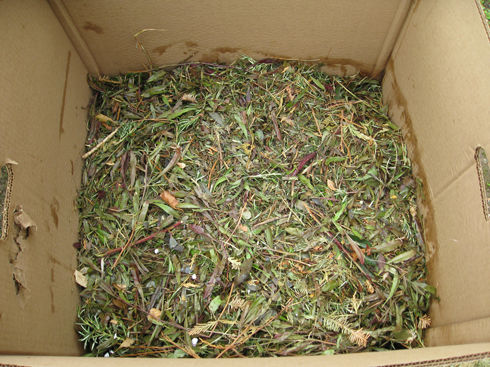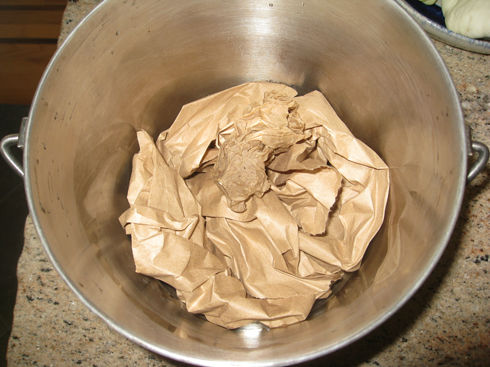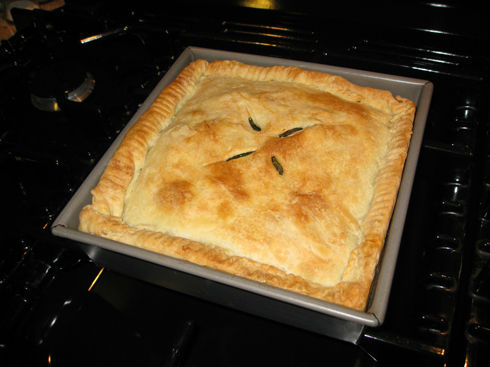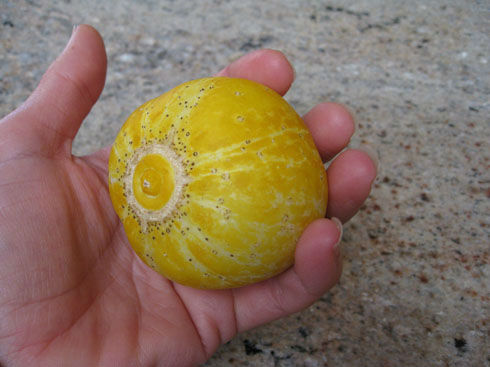I just completed a 5-day composting intensive workshop presented by Alane O’Rielly Weber. Much like my experience with Jon Jeavon’s Grow BioIntensive workshop, this intensive class has re-swizzled the way I think about everything underground.
I knew about the Soil Foodweb, the intricate web of microbial life that exists in the soil and facilitates nutrient uptake in plants (which was first written about by Dr. Elaine Ingham), but I didn’t quite have a handle on how to create a healthy environment for those microbes to co-exist in my garden or compost bin.
5 days is a long time to be talking about compost, and I could go on for hours about what I’ve learned, but here are my major “a-ha!” takeaways from the course:

1) Use More Water – A LOT More – when building a compost pile, we’ve all been told to water it well. “Wet like a rung out sponge” is the guideline to use. When building a pile, have the hose on with a sprayer nozzle and water each layer thoroughly. Sure, I knew this, but nothing prepared me for the amount of water Alane used to build her compost pile.
CompostTeana’s truck was on site, complete with a holding tank full of water. We used about 75 gallons to build our first pile. When we finished building the pile, Alane had us immediately turn the pile and water it again as we did, just to insure that it was wet enough. The next day, she took a handful of steamy compost material from the pile and squeezed it. If she was able to squeeze a drop of water from the material, it was wet enough. If not, we needed to add more water. It was astounding. My takeaway: I haven’t been using nearly enough water – no wonder my compost is not biologically active.

2) Nitrogen is Still Nitrogen, Even When Dry – when we grow compost crops and chop them down to put in the compost bin, even if those nitrogen-rich crops dry out after they are cut down, they retain the same amount of nitrogen they had when you cut them. This solved a dispute in our household about using garden trimmings immediately vs. letting them sit until we need them. So grow those cover crops, prune those hedges. It’s okay to let them dry out before shredding them and adding to the compost bin. They will always be nitrogen crops. Crops that dry while in the ground are carbon – just to clarify.
3) Anaerobic Bacteria Sucks – again, this is something I already knew, but to hear the science behind it was fascinating. Once deprived of oxygen, anaerobic bacteria multiply, causing the stinky smell in your compost bin. The interesting thing is that it goes dormant once the pile dries out, and wakes up again when wet. Using compost that has gone anaerobic is basically like using contaminated soil. Alane suggests only using it as a mulch so that it is constantly exposed to air, keeping those nasty bacteria dormant.

So, if you collect kitchen waste in a bucket in your kitchen, you’ve most likely experienced the whole container going anaerobic – stinky, foul smelling glop. Yes? Here’s the solution we discussed to prevent this from happening, so you aren’t adding bad bacteria to your compost pile. Crumple up pieces of newspaper or cardboard at the bottom of the bucket (shown above). Then the liquids will fall through and be absorbed into the paper, rather than breeding anaerobic bacteria. You can also freeze your scraps, which ruptures the cell walls, making it easier for healthy bacteria and fungus to start breaking food scraps down when you put them in the compost pile. Good tips all around!
So much became clear during my 5 days of immersing in compost. I hope to share more with you again soon.



Pingback: Soil Food Web Intensive - Part 1 - Gardenerd
Pingback: Up Close and Personal with Compost | Gardenerd
We were told that many of the microbes go dormant when the composting process is finished. They “reawaken” once the compost is watered after adding to soil or made into compost tea. It wouldn’t hurt to keep the compost a little moist when storing it.
The earthworms are likely leaving or dying if they exposed to heat and sunlight in a small container. If you use a rubbermaid bin that’s about two feet tall or so, it should be big enough to give them a cool dark place to hide. That said, Alane Weber throws wet burlap sacks over her compost bins to keep them cool before use.
Does that mean that compost I store after it has been sifted should also be kept some what moist? I sift it and the earthworms go right through, if I use it right away, they go to the garden beds. But if I don’t used it right away and the temperature is warm, I can only assume they died because when I use it later, the earthworms are gone. Yikes! What would be the best way to store it and keep all the benefits of the compost?
I store my finished compost in plastic garbage cans with an air space at the bottom (a layer of new straw – a flake or 2, or using plastic flats and shade cloth) for drainage and make occasional airspaces along the vertical column; this specifically for maintaining good air pockets and spaces for proper oxygen reserves. I do not screen my compost before forking it into storage cans, but leave the chunks and sticks and stems in to act like a time release food (the microbes keep ‘eating’, esp the fungi) and also to provide more air pockets and spaces. Sifting reduces the between particle air space to almost nil, and disrupts the little communities of microbes still functioning in micro sites. There is less disruption of the microbes until the time you need it. It also stays moist longer when placed un-screened in the storage bins – and keep them out of sun! and in triple digit heat, drape wetted cardboard over the containers to keep it really moist. This is the same thing one might want to do for a worm bin too on those really hot days. It helps the microbes survive.
Even though Christy’s reply to Janice’s doubt seems legit,75 gallons sounds a tad too much. I would use the same amount next time but I would have that lingering thought in my head about whether I am using too much 🙂
I used to chop everything up by hand, but it’s time consuming. You can run a lawn mower over an even pile of biomass. You can also put it in a trash can and use a weed wacker – note: the person who suggested this idea to me said that your trash can has to be strong because weed wackers can cut through cheap plastic cans. You can also put things in a pile and drive a shovel into the mass repeatedly in different places, or snip at it with large pruning shears.
I hope this helps.
I made a pile of dried fallen leaves, arborist wood chips, straw and pulled weeds mixed with fresh or dried grass clippings. In one pile, I chipped all the big weedy greens and found that the “mastication” of that material did 2 things: released the nutrients for bacteria to consume and grow faster so heat came on more quickly AND the pile broke down the green stuff and went into the cooler fungal phase about 2 weeks faster than the pile that received no chipping at all. Maybe, depending on the materials, chipping is not necessarily needed. And, if there are some big chips and chunks left when one wants to use the compost, just screen it out and use that material as an inoculate for beneficial microbes. ?? make sense? Besides, chipping everything down to a small size, leaves a compost pile more vulnerable to oxygen loss, an even bigger issue.
I’d add something we’ve learned, namely that compost reaches a point after the initial breaking-down phase where it begins its actual humus-building. That’s what produces the long-term soil benefits. After the humus-building stage comes mineralization, when nutrients within the compost become more and more available, and less and less stable. If you leave the compost pile moist, that process will continue and you’ll lose nutrients to the atmosphere.
Ideally you want to stop the decomposition process before that happens, (which we also do by sifting and storing it dry). Then, as Christy says, the microbes go into stasis. When you apply it to the soil and it absorbs water, the process continues on to mineralization near the plant roots, which can take advantage of the increasingly available nutrients.
So to sum up, we keep it dry once sifted.
I think there might be some mixed messages in that explanation. When composting, the bacteria and fungi consume organic matter and store it, so to speak, in the protoplasm of their new and expanding bodies. So the energy/minerals/nutrient goes from dead organic matter into bacteria and fungi bodies, and it stays there until the next level food chain critters (protozoa/nematode) consumes the bacteria and fungi. Then, the stored energy/mineral/nutrient is shifted to the body of the protozoan/nematode doing the chomping and, as life goes, some gets pooped out. THAT “poop”is the mineralization that Dan R-M is referring to, which also occurs when the protozoa and nematodes then get eaten and on up the food chain. All that poop is the mineralization of what once was raw organic plant material. So, if you leave compost moist, it will continue to “age” which means more protozoa & nematodes will eat more bacteria and fungi, pooping it out in tiny, elemental bits of soluble nutrient. If it doesn’t go anaerobic in storage, most of it will remain, but be sucked back up in a feed-back loop with the bacteria and fungi. Eventually though, the energy will shift on and on up the food chain, changing the ratio of microbes, and allowing the organic matter to approach more and more a humus state: very, very complex and long carbon chains with nutrient/minerals ticked into that molecule chain. Dr. Elaine Ingham gives compost about a year before it begins to loose it’s best compliment ratio of microbes. WHEN COMPOST DRIES OUT COMPLETELY, THERE IS ALWAYS A SIGNIFICANT LOSS OF LIFE IN THE COMPOST MICROBIAL WORLD. Yes, many of them can go to sleep, but not all. Since it is better to have diversity, it would be better to keep it moist & properly aerated and use it before it is a year old. Make more, often. AND, THE BEST PART OF COMPOST IS NOT THE SMALL AMOUNT OF SOLUBLE NUTRIENTS THAT COMES ALONG WITH THAT LOVELY DARK BROWN SPONGY MATERIAL, IT’S THE MICROBES THAT ARE THE MOST VALUABLE. If the right ratio of living microbes is in the compost, they will mineralize more nutrients right in the soil where you put it, and then migrate and mineralize more in the soil that is treated. I don’t mean to pick apart a fine point, just want folks to fully understand.
Any suggestions on how to shred compost material without purchasing a shredder?
Thank you,
Joanne
I hear you. The thing to remember is that when compost dries down before it’s done processing, those microbes die. I had some finished compost that had dried out several times during the process, and we looked at it under a microscope. Even though the finished product looked moist, there was barely any microbial activity.
Alane suggests covering compost bins with cardboard or burlap during hot times to help prevent evaporation and to keep the bin from baking. Also, we keep a bucket in our shower to catch water and use that to water potted plants and compost piles during dry season.
I hope this helps.
I’ve thought and thought about those comments the day we were building the piles and here’s what I’ve come up with: 1. There was a playful/fun atmosphere, mixed with a little unmindful helter-skelter’ness (know what I mean?) at the time of building, THAT much water did not need to be used. I was not mindful about that element, at the time, in that group of 30 or so folks, who were playful and animated from being cooped up in a dark room the rest of the day. If one were to use a fine spray hose (hey, they make us use fine sprays on the shower heads to conserve water), and very consciously sprayed the organic matter as it was going in the bin, and not the side of the bin, the folks standing around it, or the same spot that just got doused, it could be done with almost no run-off (that’s wasted water) and, I guestimate, about 1/4 the actual water we used for each starting pile (that watering while setting up and watering again at the immediate mix & turn). I’ve been meaning to get my thoughts out to all the “immersion folks” for a while now. Thank you for embracing me and the information – much of it directly from from Dr. Ingham and the rest from my careful observation of living her research. Mahalo!
Alane! Thanks so much for clarifying. I’ve been using more water on my piles, but not to the point where there is any run off. So I think we’re striking a balance here. Before your class I was barely watering my compost, so it was (even if we excited students were overzealous with the water) still an eye opener for me. Things are looking much better in the compost bin since then. Keep us posted if you come back to Southern California for another class. We’ll post it here on Gardenerd.
Thanks, Christy – very helpful tips. Although I’m a little conflicted about using that much water for composting – especially during this dry spell we’re in, I’m reluctant to use more water than absolutely necessary. Sounds like it might be okay to let the compost pile dry out for a while until it’s more feasible to use lots of water…?